Today I’m going to talk about how to use content marketing to grow your SaaS company.
Content marketing doesn’t only help brand awareness — if done properly, it drives KPI performance and increases your bottom line.
I’ll explain how you should set up your strategy to get the highest return from your content marketing approach.
There’s nothing more powerful today for a SaaS company than a solid content marketing strategy.
Content marketing for SaaS companies isn’t just spitting out content for the sake of content. It’s more than just brand awareness.
It’s how you can build trusting relationships with your audience while meeting business objectives.
It’s a long-term business strategy, not a short-term marketing solution.
Content marketing for SaaS companies is a significant investment in the long-term, sustainable growth of your brand. It isn’t a tactic, and it doesn’t give you instant results.
If a website is your gym membership, then content creation is the equipment inside and a content marketing strategy is doing the right exercises, with the right form, the right amount of times to reach your goals.
Here’s a guide to setting up your strategy for winning.
How to develop a content marketing strategy for SaaS companies.
Let’s start by getting some definitions down so we’re on the same page about what content marketing for SaaS companies really is.
What is inbound marketing?
Content marketing for SaaS companies will be a part of your inbound strategy.
Inbound marketing is the umbrella under which content marketing sits. Inbound marketing is strategically attracting and retaining a clearly defined audience through various means, one being content marketing.
Another example of inbound marketing is word-of-mouth marketing. It’s the long-term branch of your marketing strategy that works in the background while you’re prospecting and making sales calls.
Sales calls and prospecting are a great and necessary way to get your business moving early on. But the only way to position your brand as a leader in your industry vertical is with a long-term and consistent inbound strategy.
This means being present across all channels: social media, search engine optimization, content marketing email marketing and more.
Let’s see how to leverage content marketing for your SaaS company.
What is content marketing?
A content marketing strategy and content creation are not synonymous.
Just because you’ve decided to take on some freelancers to write for your company blog does not mean you’re now content marketing.
Just because you post a few things on Instagram and Facebook does not mean you have a content strategy.
According to the Content Marketing Institute: “Content marketing is a strategic marketing approach focused on creating and distributing valuable, relevant, and consistent content to attract and retain a clearly defined audience — and, ultimately, to drive profitable customer action.”
If your content is not moving toward profitable customer action, it’s not content marketing. It’s just content creation.
More things content marketing for SaaS companies is not:
- Pitching your product or service in online content
- Talking about company announcements/news
- Creating content more for your peers than for your customers
It’s simply providing relevant, educational, insightful and useful content to your prospects. Content that helps them solve problems. But in a way that meets your business goals.
Your content marketing should meet goals across many departments:
- Raising brand awareness
- Meeting performance KPIs
- Serving user needs and the user experience
- Helping the sales department close leads
Without buy-in from all the stakeholders, it will be hard to move forward effectively.
There is no marketing without content
It doesn’t really matter which content channel you choose to use or prioritize, you’re going to need excellent content.
Here at Flying Cat Marketing, we see all the different channels as tools and steps in a comprehensive content marketing approach.
That means that we don’t believe the following as channels that should stand alone:
- SEO
- Social media marketing
- Inbound
- PPC
- PR
All of these should be in line with one overall strategy. They should all work together as a part of a greater content marketing strategy to attract, qualify and close leads (and delight customers!).
Content marketing meets many goals
Don’t let the word ‘marketing’ fool you.
Content marketing isn’t just about promoting your brand, your product or your services.
The purpose is to attract and retain your audience.
And you don’t retain an audience with cheesy self-promotion.
You retain them with value and insight.
Make sure all your departments understand the main goal of content marketing.
Too much focus on ROI will take away from the user experience…
Putting everything into UX will make you fail to achieve your business objectives…
Taking the ‘marketing’ part too literally will make the content too promotional and will put off your audience.
It’s a delicate balance. Take it like you’re courting or dating your audience. Someone you’d like to get into a relationship with.
You have to go for it but slowly, and give the other person time and space (without letting them forget you). You have to give them value.
Creating a buyer persona
Content marketing for SaaS companies only works if you have a clear idea of who you’re selling to.
One of the main issues in content marketing for SaaS companies today is too much focus on vanity metrics like traffic and engagement, and not enough focus on whether there’s a content-customer fit.
They have built their buyer personas by guessing and assumptions. You’re writing posts about “how to grow my business” but you’re targeting experienced C-levels that are closing multi-million dollar deals…your content isn’t going to appeal to them.
Also, we focus too much on ‘what’ the person is and not enough on the ‘who’. Your buyer persona should answer more than just job title and demographic issues.
You should be asking:
- What are this person’s day-to-day triggers? (What made them say “that’s enough” before they started seeking your service or product)
- What are their challenges? (A higher-level view of their triggers)
- What’s a win for them?
- What topic gets them as enthusiastic as a gossiping teenager?
- Who do they answer to? Who’s expecting things from them?
- What are their main goals professionally?
- How can you take them closer to those goals?
Marketers probably have the least amount of contact with the customers out of everyone in the company. That puts you in a weird position.
You can figure out the answers to these questions by speaking to the sales department, customer success, and the customers themselves.
If you focus on answering questions your clients have actually asked your sales reps, you’ll have a goldmine of content. This will get you even more qualified leads and a shorter sales cycle.
The next step is understanding where these people are in the buyer’s journey so you can make sure your content relevant to them.
Make sure that this is up-to-date and that you keep updating your data as well. People change jobs and provide bad emails. You can use data quality tools to maintain this if you have a huge list or manually make sure you stay on top of your ICP and actual contacts.
Mapping the buyer’s journey
The next step in your SaaS content marketing plan should be to map out your buyer’s journey. The buyer’s journey is a more fluid and change-friendly version of the sales funnel. Today’s buyer is totally unpredictable and any model of their buying behavior needs to be open to change.
The buyer’s journey is your marketing lifecycle.
Why is the buyer’s journey or marketing lifecycle important to content marketing for SaaS companies?
Basically you need to create different kinds of content for them depending on where they are in the cycle. There are three basic stages in the buyer’s journey:
- Awareness
- Consideration
- Decision
We’re going to consider all of these stages when creating content. The users at each stage of the funnel have very different intent.
At the awareness stage, they are just discovering they have a problem, and they aren’t looking for a solution yet. This is going to be informational, top-of-the-funnel content where you get the most amount of traffic (and least amount of conversions).
Consideration-stage content should be longer, more in-depth, more specific. It can be in the form of:
- Blog posts
- Ebooks
- Guides
- Templates
- Slideshare
- Etc.
These are people who are already aware of the problem and are now looking for solutions (which you have!).
Decision-stage content should help them choose you as a provider. This will be service comparisons, case studies, free trials and the like.
You should map out what kind of questions your customers have at each stage of the journey, and how you’re going to answer that with your content. Then, we’re going to use this when creating our plan.
The most important thing is that your content all lines up, it all is working toward the same goal. Don’t have one kind of content only working for traffic, when you could have it work toward your ultimate business growth goals.
Creating a content marketing plan
Content marketing for SaaS companies won’t work without a solid and dynamic plan. You can write beautiful, compelling copy, but that doesn’t mean it will pay the bills.
Unless you’re a news website or your monetization model is ad revenue, you’re probably making money from sign-ups, demos and calls. That’s why SaaS companies and startups need a content marketing plan that will translate into those things.
How is this plan defined? The main thing driving your content topics should be keyword research and feedback from sales (as well as market research/validation calls with your prospects).
Let’s start by the first bit: keyword research.
Creating content for search
There are all kinds of content you can create in a marketing plan.
But there’s one kind that compounds in traffic and gets the users right when they need you.
That’s search content.
Social media is good for raising awareness, but it’s not good for conversion and the traffic will die back down after a day.
If you want intent-based, conversion traffic, you need to create content for search.
Content that people find when they need you. Content that keeps working for you in the background and only gets better with age (provided you keep it fresh and up-to-date!).
So let’s start with figuring out how to create the right content for search.
How to do keyword research in content marketing for SaaS companies
The main thing I want to push, I mean the fuel that’s going to start your engine, the driver of your growth is going to be keyword research.
Tip: In keyword research, the final goal is to appeal to your customers, not compete with your competitors. Taking a customer-first approach will help you get better results.
A good keyword isn’t just one that gets you traffic. A good keyword:
- Has the right intent (someone is looking for something you can offer)
- Is something your buyer is looking for
- Has low competition and high search volume
I say in content marketing for SaaS companies, keyword research should take up equal importance as content creation and content distribution. Some of the best keyword research tools out there are:
- Ahrefs – Track links and keyword research
- Ubersuggest – Keyword difficulty and volume
- AnswerThePublic.com – Questions people ask search engines
- SEMRush – Keyword research
- Moz – Track rankings for keywords
Remember — getting traffic and getting leads should not be mutually exclusive. When you prepare content marketing for your SaaS company, you should search for keywords that will help you generate leads.
The purpose of keyword research is to make sure you’re using the right terms people are looking for so they can find your page while they search.
The best and easiest place for them to find you is page 1 on Google.
How can your SaaS company rank on Google?
Some people might say SEO is dead. It’s not dead. Perhaps alone it’s not enough to get your company to scale and compete.
But without it, you’re missing out on a lot of free traffic and leads. Ignoring search traffic is not a route you want to take.
Search traffic a way to get free traffic and free leads. The majority of traffic to websites still comes from search. On top of that, it’s intent-based traffic that gets higher conversions. But what exactly drives Google rankings?
There are some factors you can’t control, some you can’t directly control, and some that you can.
Let’s focus on the content marketing factors you can control to rank better on Google:
- Page speed
- Mobile-friendliness
- Low competition keywords
- High search volume keywords
- Search intent
- Using keywords appropriately
- Content recency
- Keyword in headings
- Internal links to a page
- Reading level
And much, much more. Let’s take a closer look at keyword research and how to find the perfect keywords for your content to rank better.
Keyword research
One of the most important things when setting up your content marketing plan is keyword research.
Some people say spend 20% of your time creating content and 80% of your time distributing it.
I say spend 30% of your time doing keyword and customer research, 30% creating content, and 30% distributing it.
Proper keyword research is what will make your content rank for the right searches at the right time. It helps you understand:
- What people are searching for
- In what format they want it
- How many people are searching for it
- How many other people are ranking for this keyword
Do not always assume what you want to rank for and what your audience is searching for is the same thing.
You need to approach this as a scientist: with a hypothesis, but already ready to be proven wrong and accept another conclusion.
Introducing the long-tail keyword
If you’re a SaaS company that works in the real estate industry, you may be tempted to try to rank for ‘real estate’.
But I have good news: that won’t work.
It’s good news because I’m saving you tons of effort and money. Even if you could miraculously rank for that keyword, the intent of the searcher wouldn’t be clear.
Are they looking to buy real estate?
Become a real estate agent?
Maybe they just want a dictionary definition of ‘real estate’?
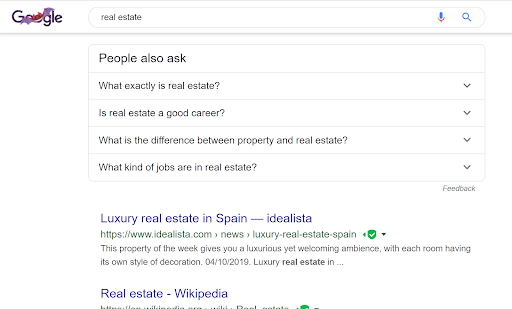
Its broadness makes it impossible to tell what the searcher wants. You need to get a lot more specific. Your searchers are being specific, and if you can match their intent then you’re in a much better position to meet them where they need you.
In this case, you could try ranking for “real estate automation platforms”.
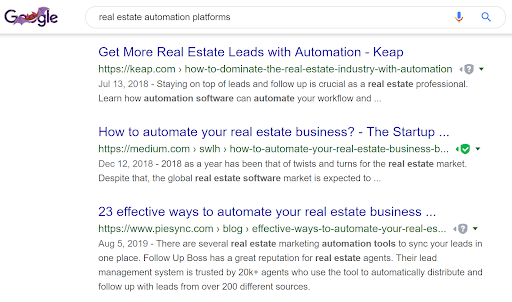
There’s a much smaller search volume for this term.
And that’s a good thing!
You can see the people searching for this are real estate professionals looking for ways to streamline and automate their business. If you have the solution, you’re far likelier to target the right people.
Some other ways to build your long-tail keyword topics are looking at the suggestions that Google gives you.

You can also look at the ‘People also ask’, which will become extra-relevant and valuable with Google’s new BERT update (more on that below). This is pure gold for your content ideas:
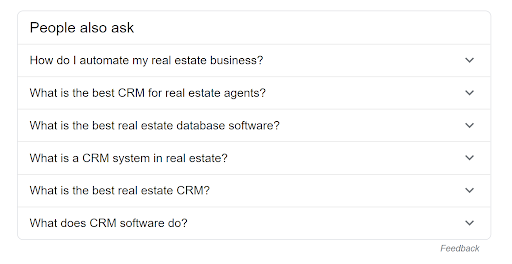
And finally, you can scroll all the way to the bottom and check out the related searches:

Gather a bunch of topics together based on these long-tail keywords. These will form the basis of your content strategy.
But one thing you never, never want to ignore is search intent.
Search Intent
Search intent is probably the most important thing to be aware of in your keyword research.
Satisfying search intent is Googles #1 goal and trumps everything else.
The main question to ask yourself here is: “what is the searcher looking for?”
And then you want to answer that question.
In late October 2019, Google announced the BERT update, its biggest algorithm change since RankBrain.
BERT means Bidirectional Encoder Representations from Transformers.
It’s Google’s attempt at better understanding how people express their needs.
The goal is for searchers to get their exact questions answered or issue resolved through search content.
So the more specific you can be answering a person’s reason for searching for something, the higher your content will rank.
A word about BERT
Pandu Nayak, the VP of Google Search, explains how Google attempts to use language to provide the best content to searchers:
“When people like you or I come to Search, we aren’t always quite sure about the best way to formulate a query. We might not know the right words to use, or how to spell something, because often times, we come to Search looking to learn–we don’t necessarily have the knowledge to begin with.
At its core, Search is about understanding language. It’s our job to figure out what you’re searching for and surface helpful information from the web, no matter how you spell or combine the words in your query. While we’ve continued to improve our language understanding capabilities over the years, we sometimes still don’t quite get it right, particularly with complex or conversational queries. In fact, that’s one of the reasons why people often use “keyword-ese,” typing strings of words that they think we’ll understand, but aren’t actually how they’d naturally ask a question.”
It’s made to understand the context of queries. Today Google rewards content that answers specific questions rather than content using the right percentage of keyword density.
That’s why when you do you research, you learn to understand the intent of the user. How do you do that?
By looking at the top 10 pages (page 1 of Google). What question to they answer? What format are they in? Are they:
- Listicles
- Landing page
- Product page
- Homepage
Etc.?
You should not try to reinvent the wheel. Create content that’s in the same format as the top 10 pages.
Your goal here is twofold:
- Best serve and match the search intent
- Make sure the intent is one that would align with a potential buyer
Cross-check that with your topics and then you can move forward to writing blog posts and creating content based on this research.
The next step in your content marketing strategy will be to retain the visitors you’ve managed to attract through this content.
How do you figure out search intent?
Take the keyword you want to rank for. Let’s say you have an awesome organic traffic SaaS solution that bypasses the Facebook algorithm.
You have an awesome case study about a brand that used a tool (yours?) and built a massive following without spending a dime on ads.
And you want to rank for “beat the Facebook algorithm”.
Well, if you type that into Google, after the videos, you see these:
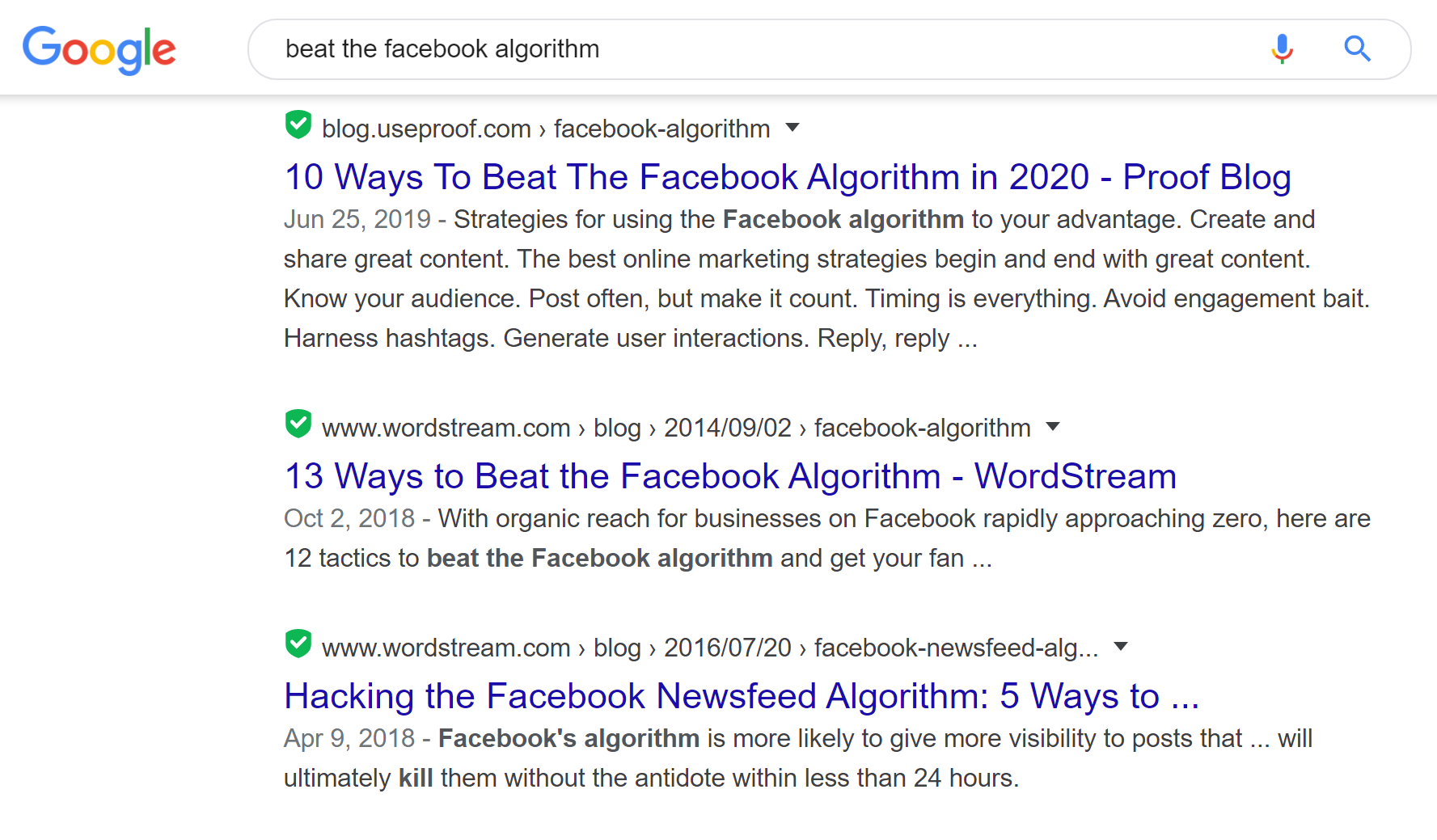
Google has determined these to best match the search intent of someone using this keyword.
It calculated that by:
- How much time somebody spent on the article,
- How quickly they clicked back to look for another article and more similar stats.
Your case study wouldn’t work here, because people searching for this keyword are looking for several strategies for beating the Facebook algorithm.
These are all listicles. So you should write a listicle too, but a better one.
A good tactic here would be to find better ways to beat the Facebook Newsfeed algorithm and make a better listicle than the top ones here. That’s how you match the search intent.
But now that you’ve attracted people to your page, is that enough?
No. If you aren’t getting your readers to take profitable action after they get to your page, you do not have a successful content marketing strategy.
When you’ve gotten them to your page, you need them to convert, you need them to take the next step in the buyer’s journey. That’s when lead generation comes in.
Lead Generation
While creating the content is a form of demand generation (attracting people to your business), lead generation is the next step. You’ve introduced yourself, but you don’t want to lose touch with your visitor.
Most people who come to your website will leave.
And maybe never come back.
It’s not because it’s bad.
It’s just because they got the information they needed and they aren’t ready to purchase yet.
Ninety percent of people who land on your website will not be ready to make a purchase yet. But they will be, eventually. That’s why you want to stay in contact with them.
They aren’t saying “no”, they’re saying “not right now”.
So you’ll need to create something that they’ll be excited about giving you their email address for. This is called a lead magnet.
The lead magnet
It’s important to have a lead capture mechanism in place as you roll out your content strategy.
There’s no other way to stay organically in touch with your audience and continue delivering value to them.
Every time you get a visitor to your website, there should be a mechanism in place to get them onto your email list.
The lead magnet can come in many forms and depends on what stage of the journey your prospect is in. Things that work well are:
- Quizzes
- Tools
- Templates
- Checklists
- Toolkits
- Podcasts
Something short and sweet. And, more importantly, something that’s directly related to the reason the searcher has arrived to your website.
CoSchedule has a tool that drives leads like crazy: the Headline Analyzer:
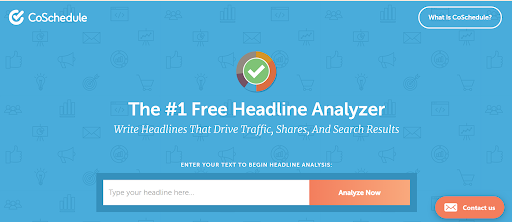
It’s a tool that analyzes your headlines for the most clickability.
You type it in, and it gives you a score out of 100 with tips on how to improve.
Once you type your headline in, you have to give them your information before you get your results.
This lead magnet couldn’t be better.
CoSchedule’s target audience is content and social media managers and marketers. These are people who care about good headlines.
Give them a tool that promises seductive headlines, you bet marketers will give you their info faster than you can say ‘lead’.
Aim to have one on each page, and aim for it to be exactly relevant to the post they landed on.
For instance, on this post by Hubspot:
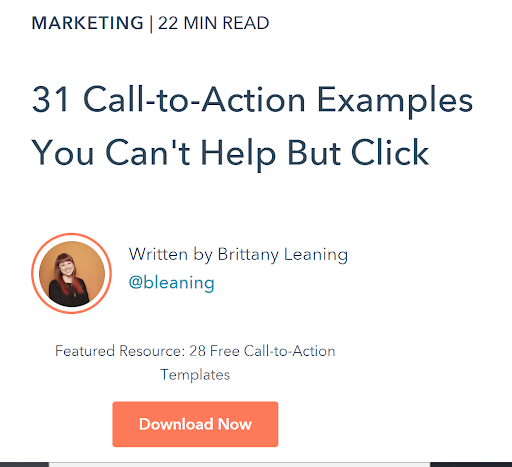
You’ll see the blog post is “31 CTA examples”, and the lead magnet is “28 Free CTA Templates”
Whoever came to this blog post was looking for CTA examples, and they’re offered free templates. The searcher was obviously looking for ways to write better CTAs. That’s what they were looking for, and that’s what they will get.
Let’s see how we can take your readers down the pathway of visitor to customer.
Conversion pathway
The conversion pathway takes your visitor from your blog post or landing page to your email list.
This pathway is more than just your blog post and a lead magnet.
It’s a 3-step pathway that every conversion should follow.
It’s the CTA (call-to-action), landing page, and thank you/delivery page.
The call-to-action
Every piece of content on your website should have a CTA somewhere, asking your readers to do something.
We’re trying to get profitable action from your readers, but we don’t want to ask them directly for the sell.
Instead, we’re just going to take one step further and ask them for their email.
There are many kinds of calls-to-action.
You have:
- Sign up. To an event, a free trial, and online course?
- Subscribe. For more fantastic content like this.
- Free trial. Does your SaaS company have a freemium model?
- Learn more. Give them more information.
- Join us. Have your readers join your community.
They don’t all need to be worded this way, but these are the intentions behind them.
Pro tip: Don’t only use one CTA all the way at the bottom of your page. Give your readers multiple opportunities to convert: above the fold, mid-page, and at the bottom.
Don’t use boring, wishy-washy language like ‘submit’ or ‘buy now’. Instead, paint a picture of what the person will get when they click the button.
For example, in the CoSchedule Headline Analyzer, they have ‘Analyze Now’, not ‘Sign Up’’. We forget we’re actually signing up for a mailing list. Instead, we’re excited to analyze our headline.
Make sure your CTA is on point, because it’s the first step to getting your reader on your list.
The next one is your landing page.
The landing page
A landing page is one build with a single conversion purpose in mind. You are offering one and only one thing to the reader, and this is where you’re going to sell it.
You’re not going to talk about the features of what’s inside, but rather the benefits.
This is copywriting basics, but it’s important that you have it drilled into your mind.
On this page, you’ll write a brief introduction of what’s in the lead magnet, and list some bullet points outlining what their wins will be after they’ve consumed your content.
For a quick lesson on the difference between features and benefits:
- Features are what your product has or is. High-tech accounting software that uses AI to manage suppliers. A socially driven loyalty program that uses social shares and likes instead of purchases to build loyalty.
- Benefits are the outcomes or results your user will get after using your product. This is the reason people will become your customer. For the above examples, they’d have to spend less time manually assigning tasks and payments. In the second example, they get a quadruple benefit: free organic marketing, reduced ad spend, and building a powerful, loyal community, which means lower customer churn.
Your landing page needs to list the benefits of the lead magnet. How will downloading this PDF be a win for them? A quick one, at that?
Use another enticing CTA on this page to get them to make the final click. Make sure the CTA itself conveys the main benefit from downloading this PDF. Every word counts.
Thank you/ lead magnet delivery page
Make sure you thank your reader for giving you their email.
Repeat the benefits they will receive from the lead magnet.
And deliver something awesome they can quickly consume and — more importantly — quickly use. Something that will immediately take them closer to their goal (remember, the thing they were trying to solve when they were searching on Google?).
This is the most basic conversion funnel.
Conversion pathways are how you will nurture, engage and convert your leads into sales. Without this, your blog is just a blog, and not content marketing.
Promoting your content
While search is my favorite, it wouldn’t be very prudent for your brand to rely solely on search traffic.
As I mentioned in the first chapter, your content marketing strategy should be 30% research, 30% creation, and 30% promotion. The majority of content you make may never be seen if you don’t push it out into the world.
You should plan how you’re going to promote your content to begin with.
For every blog post you write, you should consider the following:
- Is it linkable: is this blog post original, super useful, or packed with data? Will someone want to link back to this?
- Do I know someone who would share this with their community? Did you mention anyone in the blog post? Do you know people who are interested in this topic and who would want to share?
- Is my headline attractive and clickable? Be sure to use the CoSchedule Headline analyzer for every headline you write! I have no affiliation with them I just think this tool is fucking cool.
The following are ways you are going to promote every piece of content you create:
Social media
Whatever media you’re present on, push your content out there. Search does generate the most traffic to a website, but with a good social media strategy, you can get continuous traffic to your content.
Whatever platform you’re present on, be sure to share your content consistently. And not just old content, but all your content. All the time.
Post your content at least once a day. With a caption that’s suitable to the platform.
Social is great for building awareness around your brand. It’s not intent-based and not that much traffic from social will convert, but you cannot ignore these channels.
Social is different from search traffic in that they aren’t particularly looking for your content.
They don’t need you right at that moment. That’s when you need the most enticing headlines that create a curiosity gap.
Use scheduling tools like Buffer or CoSchedule to make sure your audience is always getting a fresh stream of useful content from you.
Repurposing your content
People consume content differently. And different kinds of content performs better for certain keywords.
Some keywords and people prefer video. Some people like to learn on their daily commute via podcasts. Other people can’t break down and understand information unless they read it. And some people just like to learn everything from social.
Every time you make a piece of content, see in how many ways you can repurpose it, into how many different media formats you can release it.
For instance, this blog post, now looming at 5k+ words, can be broken down into a ton of different posts for LinkedIn and other social media. I could turn it into a podcast (which at the time of writing, I don’t have yet), a few videos, shorter blog posts, value emails, and more.
Pro tip: You can repurpose one blog post into a different blog post for a guest post to get a link back to your page.
Republishing/ syndicating content
Syndicated content is when a third-party platform republishes your own content. Basically it means you’ve written one blog post or created an infographic and another website posts it natively on theirs (with a link back to your site, of course).
Huge websites syndicate content: CNN, New York Times, Huffington Post. If you can get a link back to your blog from one of those big guys, things will go very well for you.
You can also self-syndicate onto platforms like Medium, LinkedIn Pulse, and whatever other similar platforms there are in your industry.
Syndication is less about SEO and more about:
- Reaching new audiences
- Boosting social media engagement
- Establishing yourself as an authority
- Getting discovered
- Reaching a built-in audience
Remember, this is content marketing! You have to get your content out there.
Linkbuilding for SaaS companies
Link building is a crucial part of your strategy and still one of Google’s most important ranking factors.
The more (high-quality) pages link back to your website, the more Google understands that your website is important. There are a few ways to get backlinks to your website:
- Guest posting. Write a blog post on somebody else’s blog with a link back to yours. Aim to have the link back to one of your important blog posts instead of just your homepage.
- Skyscraper technique. Analyze the top 10 results for the keyword you want to rank for. Write something more comprehensive and better than all of them. Use a tool like Buzzsumo to who is linking to them, and contact those people to see if they’d want to link to your better post.
- Link roundups. Link roundups are weekly or monthly posts that share a curated list of links. “Top 20 blog posts about X”.
Before offering your link out to other bloggers, make sure your content is super useful, actionable, and original. Your link building strategy will signal to Google that your website is good.
Paid distribution
Organically, your content on Facebook will reach about 2% of your followers. That’s the mean ole’ Facebook Newsfeed Algorithm that makes it that way. Some could say it’s because Zuckerberg wanted more human connection on his platform, others could say it’s because he wanted to cash more advertising checks.
Whichever it is, the result is the same for you: you need to do a lot more to get eyes on your SaaS company’s content on Facebook.
Even though a lot of this post was about organic reach and SEO, it’s important to take every route to greater reach.
That’s where paid distribution comes in. Facebook paid isn’t only for bottom-of-the-funnel, advertising and lead generation purposes. It’s also a highly effective method for distributing your content.
You can take the free Facebook Blueprint Certification to better understand how the paid platform works and to make the most of this as a distribution channel.
Networking
Never underestimate the power of your network, which is probably the most important thing you have. Go out and meet people in person, connect with them on LinkedIn or Instagram or wherever you hang out.
It’s not only about getting a bigger network, but about having a strong one. People who love what you do and share and share values with you. That way you can support each other and share each other’s content.
The more people you can get to share your content, the wider and faster your content will spread, and the more effective your content marketing strategy will be.
Be sure you’re spending time connecting and appreciating the people who read your content. And give them love back on their content.
Every time you have a great new blog post published, send it to your main supporters or to people who may find it interesting. See if they’d be open to share it (of course, you should be open to sharing their content as well!).
Conclusion
You should now be well on your way to having a full content marketing strategy for your SaaS company.
